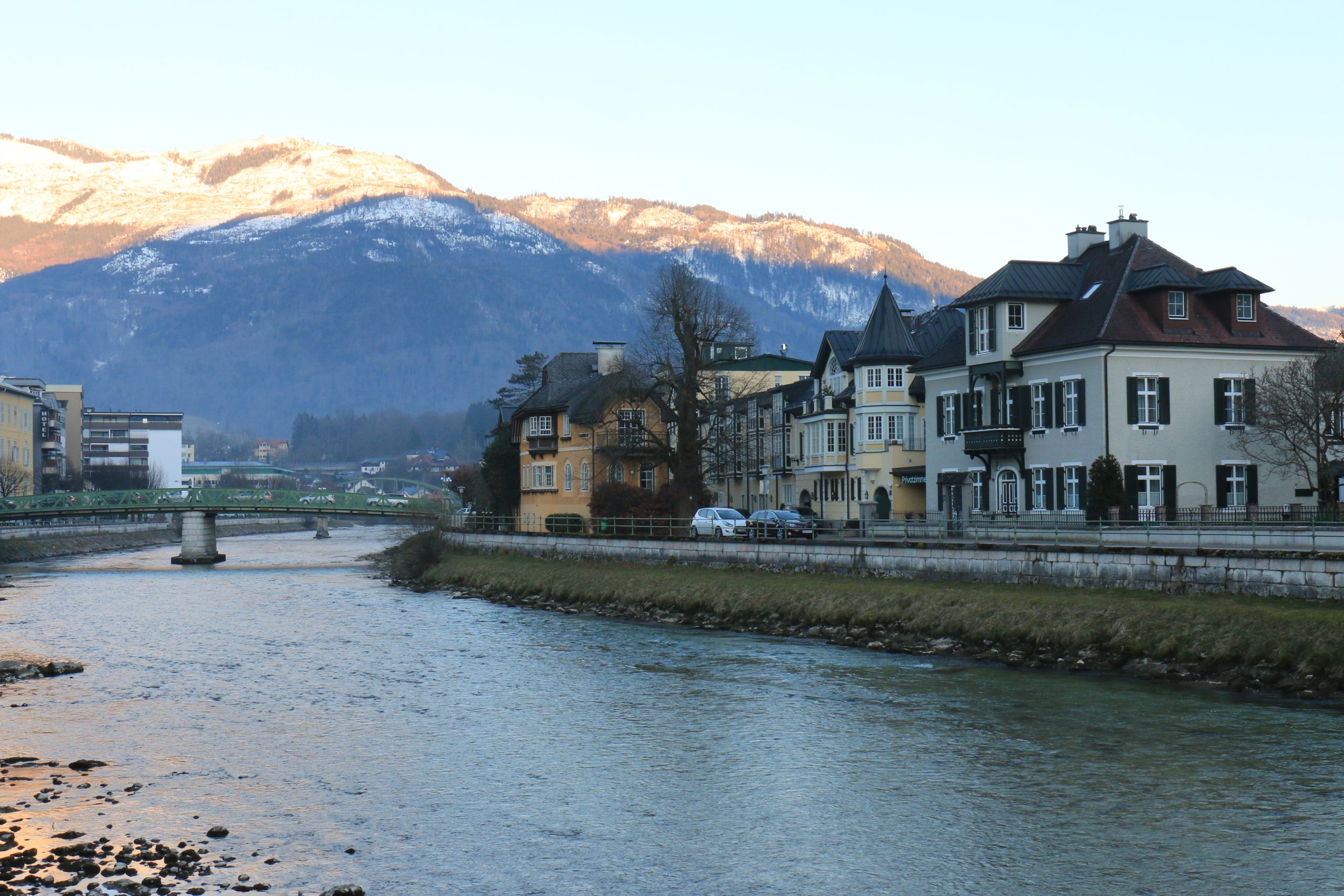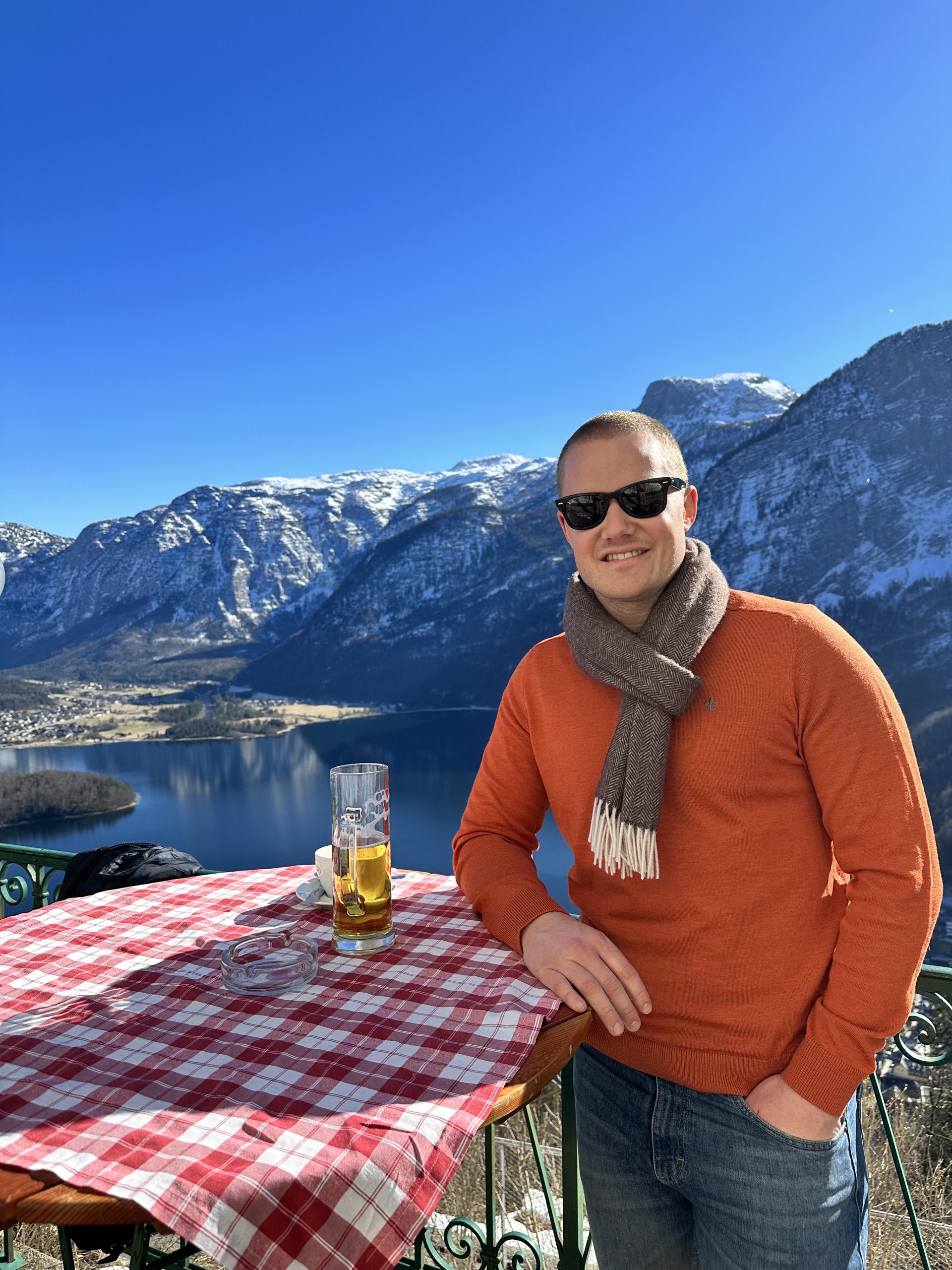7 Best Daytrips from Salzburg: Without The Need For A Car!

Salzburg is famous for its music, especially as Mozart’s birthplace. The city’s name, “Salzburg”, means “Salt Castle”. This comes from the time when salt mining was big here. The city, located by the Salzach River, was a major center for trading this mineral.
Salzburg’s old town has beautiful buildings and important cultural spots. But the areas around the city are just as interesting. There are wonderful landscapes and places with deep history just outside Salzburg. This guide will tell you about the 7 best day trips from Salzburg, and you don’t even need a car! Because who needs a list of 30 different places?
Bad Reichenhall (40 minutes from Salzburg by bus)
The first day trip from Salzburg is the charming alpine town Bad Reichenhall, located in Germany near the German-Austrian border, just a short bus ride away. This town nestles within the Bavarian Alps, presenting an idyllic scene of mountain peaks and tranquil landscapes. Stroll around the town, enjoy an Apfelstrudel at a local café, and take in the majestic views of the surrounding mountains. As the town is just a short 40-minute bus ride away from Salzburg, you can visit Bad Reichenhall in an afternoon.
Health and Wellness: Like many towns in the region, Bad Reichenhall’s legacy is closely linked to its salt-rich history. The town’s salt mines have influenced not just its economic landscape, but also its health and wellness offerings. For centuries, people have flocked to the town’s therapeutic salt baths, believed to possess curative properties for countless illnesses.
Don’t miss out on: The renowned Rupertus Therme Spa & Wellness Resort is a testament to Bad Reichenhall’s spa tradition. This thermal spa offers a heated outdoor alpine thermal bath with a breathtaking view of the surrounding mountains, several saunas, and a fitness center. With prices starting at around €30, it’s an experience you shouldn’t miss when visiting Bad Reichenhall!

Berchtesgaden (40 minutes from Salzburg by Bus)
The Berchtesgaden National Park is, simply put, a paradise for nature lovers with plenty to offer. If there’s one day trip from Salzburg you shouldn’t miss, it’s definitely this one. The local town, Berchtesgaden, boasts beautiful timber-framed buildings, local shops, cafes, and restaurants, all set against a backdrop of towering mountains.
Top things to do in Berchtesgaden
Visit Hitler’s Eagle’s Nest (Kehlsteinhaus): Situated at 1,834 meters and built as a birthday gift for Hitler, this historical site is one of the few remaining structures from the former Nazi regime in Germany. Today, it operates as a restaurant during the high season (May to October) and can be accessed by tourists via a special bus from the Documentation Center in Obersalzberg, a short distance from Berchtesgaden’s city center. For more details, check out my comprehensive guide on visiting Hitler’s Eagle’s Nest.
Königssee: A brief bus journey from Berchtesgaden’s city center will take you to the enchanting Königssee. Translated as “King’s Lake” from German, the Königssee is Germany’s deepest and cleanest lake—so pristine you can drink directly from it. You can reach it using bus 843 from the Berchtesgaden city center, a journey that takes about 7 minutes. Once there, don’t miss the opportunity to take a boat ride on the lake to fully appreciate its alpine splendor.
If you’re planning only a day trip to Berchtesgaden from Salzburg, I highly recommend the two activities above, combined with a stroll around the city center. If you’re considering a longer stay in Berchtesgaden or are curious about other attractions in the area, explore my full guide on the 7 best things to do in Berchtesgaden.

Werfen (1 hour from Salzburg by train)
World’s Largest Ice Caves: Nestled in the picturesque landscape of Werfen is the world’s largest ice cave, known as Eisriesenwelt or “Ice Giants World” in English. This naturally formed ice cave spans over 42km and boasts surreal formations of spikes and pillars. Each formation has been sculpted by nature over millennia. It’s quite awe-inspiring to reflect on! Do note, tickets come at a premium, starting at €35 for adults. Allocate roughly 3 hours for the visit, and remember to dress warmly, especially if it’s warm outside.
Hohenwerfen Fortress: This fortress gained international recognition from its appearance in the 1968 Clint Eastwood movie, “Where Eagles Dare.” Additionally, it was portrayed as Hitler’s Austrian summer house in the series “The Man in the High Castle.” One look at the fortress reveals its appeal; its majestic presence seems straight out of a fairy tale, which is a common reaction for many Austrian landmarks. The fortress offers breathtaking panoramic views of the encompassing Alpine landscape. A standout attraction here is the falconry display, where majestic falcons soar against the backdrop of the Alps, simulating hunts. Entry fees start at €10 if you opt to hike up to the castle, and €14 if you’d rather take the funicular.
Bad Gastein (1 hour 30 minutes from Salzburg by Train)
Bad Gastein isn’t just another spa town (recall “Bad” means spa), it’s also an adventure hub brimming with activities. In winter, this destination attracts many Swedes (among others) eager to hit the ski slopes. In fact, it’s often dubbed the favorite Alpine spot for Swedes — a sentiment I echo. Being Swedish myself, I first visited Bad Gastein around the age of 10 and have returned multiple times since. However, don’t pigeonhole it as just a winter getaway; its summer offerings are equally enticing!
Top Things to do in Bad Gastein:
- Skiing or Snowboarding: Naturally, if you’re visiting during winter, skiing or snowboarding is a must. It’s no wonder Swedes herald it as their top pick in the Alps. Day passes in the high season start at roughly €55 per person if purchased online.
- Gastein Heilstollen (Healing Caves): This unique spa treatment, also known as natural therapy, entails basking in warm caves. It’s scientifically backed to alleviate pain, inflammation, and bolster the immune system, thanks to the blend of heat, humidity, and radon gas. However, it’s worth noting that while the treatment has its merits, it doesn’t come cheap (starting at €80). Typically, a series of sessions spanning 2 to 4 weeks is recommended.
- Hiking: The Bad Gastein region has over 600 km of hiking trails catering to both beginner and more seasoned trekkers. For trail recommendations in the Bad Gastein region, check out this excellent resource.
- Gastein Thermal Springs: In line with Bad Reichenhall and Bad Ischl, Bad Gastein features exquisite thermal spas for utmost relaxation. Felsentherme and Alpentherme stand out as the premier spas in the area. While Felsentherme is located in the heart of Bad Gastein, Alpentherme can be found in the neighboring town of Bad Hofgastein, just a 10-minute drive away.
- Gastein Waterfall: As you stroll through the charming streets of Bad Gastein, the thunderous Gastein waterfall demands attention, plummeting from a height of over 340 meters across three tiers.
Zell am See (1 hour 30 minutes from Salzburg by train)
Located approximately 1 hour and 30 minutes by train from Salzburg, Zell am See is a picturesque resort town that offers a myriad of activities both in winter and summer. With its pristine lake and the majestic Alps as a backdrop, it’s an ideal destination for travelers throughout the year. If you tire of simply strolling around the picturesque town of Zell am See, here are some activity suggestions for both summer and winter:
Winter activities in Zell am See
- Ski and Snowboard: Schmittenhöhe and the nearby Kitzsteinhorn Glacier are your go-to spots for skiing and snowboarding. Boasting well-maintained slopes for both beginners and pros, it’s a snow lover’s paradise.
- Tobogganing: This fun-filled activity is perfect for families. Enjoy a slide down the snowy 1-kilometer track, which is suitable for children, and laugh all the way!
- Ice Skating: When temperatures drop sufficiently, Lake Zell freezes, transforming it into a vast natural ice rink. Rent some skates, glide across the lake, and savor the winter scenery.
Summer activities in Zell am See
- Mountain Hiking: The trails on Schmittenhöhe offer great hiking experiences. Traverse alpine meadows and relish the panoramic views from the peaks. There are hiking paths suitable for all fitness levels, so there’s no need to fret. For instance, check out the trail that runs along the river bank of Lake Zell to Bruck an der Grossglocknerstrasse, and then take the bus back to Zell am See. This easy trail takes approximately 2 hours to complete.
- Paragliding: If you’ve never tried it, now might be the time! Tailored for the more adventurous, soar like a bird over Zell am See’s beautiful landscapes. It’s an exhilarating way to view the town from a vantage point.
Bad Ischl (2 hours from Salzburg by Bus)
Like many smaller towns in Austria, Bad Ischl is nestled between stunning Alpine peaks although this town has the Traun River running through it. The town center is well-maintained with beautiful architecture and serene surroundings, making it well worth a day trip from Salzburg.
The Emperor’s Summer Residence: Perhaps the most significant mark on Bad Ischl’s history is its connection to Emperor Franz Josef. The emperor frequently visited the town, making it his summer residence. It was in the Kaiservilla that he signed the declaration of war against Serbia, marking the beginning of World War I.
Cultural Hub: Beyond politics and royalty, Bad Ischl was a cultural hotspot in the 19th century. Composers like Johann Strauss Jr. and Franz Lehár, along with writers such as Arthur Schnitzler, were regular visitors, drawing inspiration from its serene surroundings.
Things to do in Bad Ischl
- Thermal Spas: The prefix “Bad” in many German and Austrian town names indicates that the town is a recognized spa town. In German, “Bad” translates to “bath” or “spa”. Bad Ischl’s reputation as a spa town began with the discovery of its salt deposits. Its thermal waters are believed to have therapeutic properties, attracting those seeking relaxation and healing. The most well-known spa in the region is the Eurotherme spa resort, which exemplifies Bad Ischl’s spa tradition, offering visitors a mix of luxury and well-being. Prices start at €22 for a day pass to the spa.
- Zauner Pastry Shop: Bad Ischl offers more than just spas. Established in 1905, the famous Zauner pastry shop is a must-visit. It provides insight into the town’s significance with its opulent decor. Don’t forget to try some of the region’s delicious pastries, especially the ‘Zaunerstollen’.
• The Kaiservilla: Known as the Emperor’s summer residence, this is where the Emperor signed the order to attack Serbia, marking the beginning of WW1. The villa is now open to tourists from May to October, with tours starting at regular intervals. Entry to the Kaiservilla starts at €21 and includes a mandatory guided tour.

Hallstatt (2 hours 30 minutes from Salzburg by Bus)
Located a 30-minute bus ride from Bad Ischl lies Hallstatt, a UNESCO World Heritage site often synonymous with postcard-perfect beauty, and justifiably so. Situated on the edge of Lake Hallstatt and framed by the Dachstein Alps, this village offers a vista that seems to spring from a fairytale. Its wooden houses, mirrored on the tranquil waters of the lake, create a picturesque setting that has made it one of the most photographed spots in Austria. In fact, the influx of visitors has been so immense that locals have contemplated imposing a daily tourist limit. That said, when I visited Hallstatt in mid-February (outside of the high season), I found the number of tourists quite manageable.
Things to do in Hallstatt
- Hallstatt Skywalk: Board the funicular at the Salzwelten Hallstatt valley station to ascend to an elevation of 838 meters above sea level. From this vantage point, the Hallstatt village sprawls beneath you, and with the Dachstein mountain range as a backdrop, the panorama is breathtaking. You can savor the view while enjoying a drink at the local restaurant at the summit. It’s a delightful experience on a sunny day. Additionally, if you’re intrigued by the Saltmine, its entrance is located where you exit the funicular. Personally, I don’t find the Saltmines as captivating as the other attractions in this region.
- Take the Classic Postcard Picture of Hallstatt: Arguably, Hallstatt is the most photogenic town mentioned in this list. To capture the quintessential postcard image of Hallstatt, simply follow the shoreline until you see the iconic church behind you and the Dachstein Alps in the distance. It’s easy to spot, given the throngs of tourists. After all, it’s one of Austria’s most photographed locales.
- Have Lunch at Seehotel Grüner Baum: Like many, my wife and I often find ourselves indecisive about dining options. If you face a similar dilemma, allow me to decide for you. Dine at Seehotel Grüner Baum. This eatery serves delectable Austrian classics and offers a splendid view of the lake. You won’t be disappointed

Final Thoughts on Day Trips from Salzburg
Even though Austria is arguably best explored by car, there are numerous places easily accessible via public transportation, such as buses and trains. While visiting Hallstatt and Bad Ischl might be more challenging without a car, their close proximity allows you to explore both in a single trip. In Austria, it’s all about nature, spas, majestic mountains, and well-maintained towns. Choosing any of these destinations for your next day trip from Salzburg ensures an experience you won’t regret.
Viktor Bronner
Welcome to my travel blog! I'm Viktor, a regular guy from Sweden who is on an extraordinary mission - to visit every country in the world, currently at nr 79 out of 197. With this blog I'm looking to document the journey and to inspire you to travel more, especially to offbeat destinations.
